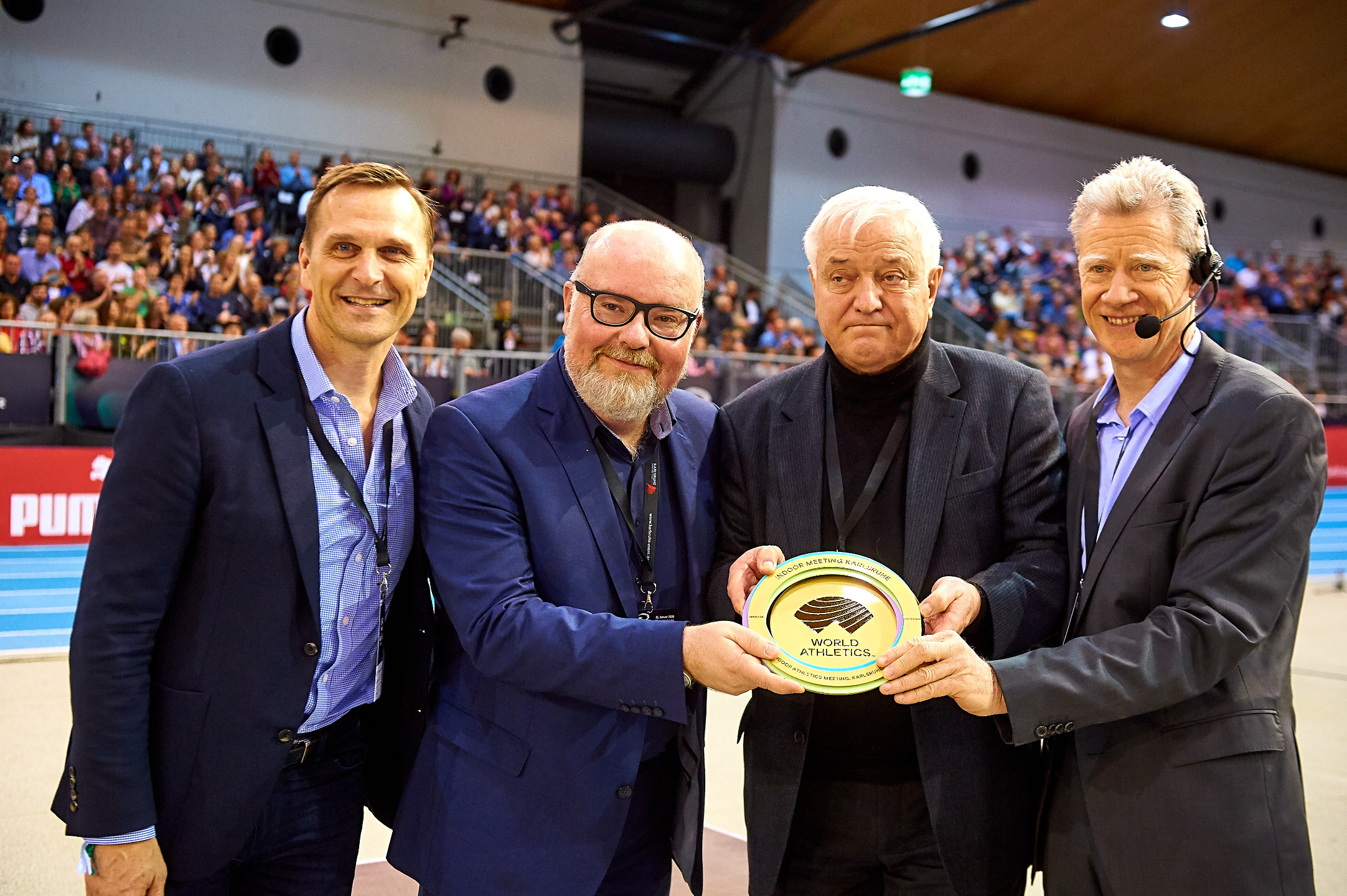05.02.2025
‘The meeting is a success story’ - Meeting founder Siegfried König, sports director Alain Blondel and meeting director Martin Wacker in conversation
When the first International Indoor Athletics Meeting was held in the brand new Europahalle on 3 February 1985, a sporting event was established that is now one of the nine international meetings of the World Athletics Indoor Tour Gold as the INIT INDOOR MEETING. In an interview with Harald Linder, meeting inventor Siegfried König and today's meeting organisers Alain Blondel and Martin Wacker talk about the beginnings, great moments and crises of an event that is now a flagship of the sports city of Karlsruhe.
40 years of INIT INDOOR MEETING in Karlsruhe. A success story?
Siegfried König: Yes, you could say that. It's the oldest indoor meeting in Germany. I'm proud that the idea I had at the time to give back some of the support I received as an athlete with the meeting has been so successful. With the support of Herbert Bohr, the now sadly deceased organiser of the Sindelfingen meeting, I was able to make this idea a reality. And so, on 3 February 1985, we organised the first ‘International Indoor Meeting (IHM)’ in the Europahalle with a team of enthusiastic athletes. Now it's 40 years old, which is just great.
Alain Blondel: The meeting is not only 40 years old. It is also part of the World Athletics Indoor Tour, which is celebrating its tenth anniversary this year. Back then, we sat down with the four other meetings in Moscow, Stockholm, Boston and Birmingham and the world federation to get a format like this off the ground. A format that is firmly anchored in the indoor athletics calendar every year. My goal and that of the team was to represent Karlsruhe worldwide. Today we can say that we have succeeded very well so far. World record number 2 in the history of the meeting: On 10 February 2008, Susanna Kallur from Sweden set the world record for the 60 metre hurdles in 7.68 seconds.
Martin Wacker: ‘This event is the most international sporting event that we regularly have in Baden-Württemberg - this is also shown by the patronage of the Minister President. Karlsruhe scores points far beyond the city limits, the television images in more than 50 nations worldwide - on all continents - are the best city marketing. The secondary effects in terms of communication are indeed priceless - and they also place us on the international world map of sport, which is an extremely important signal on the way to the World Games 2029.
The meeting is rich in stories. What have been the highlights for you over these many years?
König: There are so many that I find it difficult to emphasise a few. Certainly in the long jump the performances of Heike Drechsler, who was living and training in Karlsruhe at the time. Or the magnificent runs of Haile Gebrselassie, who attended the meeting for many years. His world record run over 3,000 metres in 1998 turned the hall upside down. The first participation of GDR athletes at the meeting in 1990 was also a great story, as was Susanna Kallur's world record in the 60 metre hurdles when I left the meeting in 2008.
Blondel: That's a difficult question, I was able to enjoy so many wonderful moments that I don't think it can be reduced to just one. But I would like to emphasise 1998, which was the first year in which I was allowed to put together the starting field on my own. And then Haile Gebreselassie's world record over 3,000 metres at this premiere, that was really great! Of course, Susanna Kallur's world record in 2008, which went through the roof in the media, was also a great moment. There's one picture I still like to look at today: the top athletes' presentation from 2003, when we had the “crème de la crème” of the athletics scene in Karlsruhe with Haile Gebreselassie, Colin Jackson, Jonathan Edwards, Wilson Kipketer and Frank Fredericks. But probably my biggest highlight is being able to work with an outstanding team year after year, and not always under the best conditions. I only have to think back to the move from the Europahalle to the exhibition centre or the challenges of 2021, when we were one of the few meetings to organise a meeting under the strictest conditions in times of coronavirus. You can be proud of the team.
Wacker: That we managed to save the meeting from being cancelled when the Europahalle was closed in 2015 for fire safety reasons and we were left without a hall. I still have very fond memories of visiting Alain in Zurich back then. He was responsible for the European Championships there. During our dinner, we received the news that the Europahalle was closed immediately. We simply had an extra glass of wine and started to think the impossible. That's the only way to accomplish a mission that is actually impossible: never look back, always look forward. Personally, I was particularly pleased that the local council unanimously supported this mission. I am all the happier that this joint decision is now bearing exactly the fruit we always hoped for: the meeting remains in the Gold Class and is back in its living room. Once again, thank you to everyone involved!

